Corporate Guide
History of the Takara Group
-

-
- Chapter 3
-
Rebuilding our Business Foundation
1966–1993
Restoring our presence in Japanese alcoholic beverages , exploring our growth potential, and facing stronger competition
-
-
1
Rebuilding the company's business foundations
-
1966
-
Appointed Takara Shuzo’s sixth president, Takashi Ohmiya revamps the business
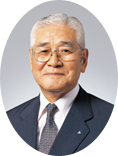
In 1966, Takashi Ohmiya (photo) was appointed as Takara Shuzo's sixth president and charged with improving the company's fortunes. The following year, in 1967, having made the decision to withdraw from the beer market, he immediately set to work rebuilding the company’s business structure. His aim was to revitalize Takara Shuzo around the four cornerstones of shochu, sake, mirin, and the research laboratories.
-

1968
-
Sho Chiku Bai leaps on marketing as a sake for auspicious occasions
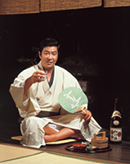
The efforts to revitalize the company bore fruit through Sho Chiku Bai. Takara Shuzo launched its CHARM Strategy with the goal of reestablishing the Sho Chiku Bai brand as Japan’s preferred beverage for celebrating auspicious occasions. Sho Chiku Bai Take, launched in 1968, was a big hit due to its light and easy-to-carry bamboo-shaped plastic container, which was a perfect fit for the leisure boom at that time. In 1970, Takara Shuzo hired the popular movie star Yujiro Ishihara (photo) to appear in Sho Chiku Bai ads, and in 1972, the advertising campaign evolved to position Sho Chiku Bai as the ideal sake for auspicious occasions. As a result, Sho Chiku Bai became the No. 1 sake in Japan for celebratory gifts.
-

1969
-
The changing face of Takara Mirin

In 1969, amidst the growing consumption of mirin as it became more affordable thanks to reduced taxation, Takara Mirin packaged in a new lightweight and unbreakable container called "Miri-Pack" (photo) was launched with the slogan, "For a housewife’s convenience." To promote the approachability of this product, the orthography of the product name was also changed, abandoning the traditional kanji characters for an easy-to-read rendering in the two basic Japanese syllabaries. The company also began working in earnest to produce condiments for processed foods and developed a fermented seasoning called Ajishirube for chikuwa, kamaboko, and other fish paste products.
-

1970
-
Construction of Central Research Laboratories
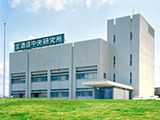
The Alcohol Research Center in Kyoto’s Fushimi Ward was renamed Central Research Laboratories in 1967, which were moved to Otsu, Shiga Prefecture in 1970. Equipped with the latest research equipment, the Central Research Laboratories now focused on applications for microorganism-related technology, which had been cultivated through the brewing business, to start full-fledged research into mushrooms and the fermentation industry. (Photo: Central Research Laboratories, circa 1970)
-

1970
-
Mass cultivation of brown beech mushrooms
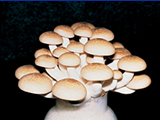
The first of the new businesses to bear fruit was the mass cultivation of brown beech mushrooms. Takara Shuzo researchers searched high and low throughout Japan and on occasion even traveled overseas to collect pure strain isolates of shimeji mushrooms, based on which, in 1970, they established a method for mass cultivation of brown beech mushrooms (photo), one variety of shimeji. This success was greeted with great surprise by mushroom growers and agricultural organizations, and the Central Research Laboratories were flooded with requests for cultivation guidance. Takara Shuzo concluded an agreement for commercial cultivation with the Nagano Agricultural Cooperative Association (presently JA Zennou Nagano).
-

-
-
1
-
-
2
Rebuilding the shochu business with Takara Shochu Jun
-
1968
-
Red Takara is launched

While sake, mirin, and the research laboratories achieved success after success, the shochu business remained sluggish, yet efforts to revitalize it never wavered. Tasked with creating a shochu that rivals top-grade brandy, the technical staff developed a gold-colored shochu that could be said to be the original "new-type" shochu: Red Takara (photo) in 1968. It received high praises from shochu lovers.
-

1977
-
The "White Spirits Revolution" and the birth of Takara Shochu Jun
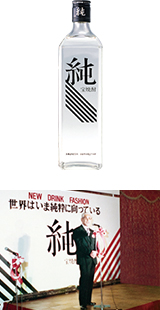
In the 1970s, consumption of vodka overtook that of bourbon whiskey in the U.S. and this "White Spirits Revolution" drew worldwide attention. This new trend toward distilled liquor would surely come to Japan. At the time, Takara Shuzo, acting on the conviction that only shochu would be capable of leading the White Spirits Revolution in Japan, launched a company-wide research and development effort to create a new shochu with "just the subtlest of flavors and a smooth swallow." In line with the catchphrase, "The world is now moving toward an age of purity," Jun, a clear and colorless shochu, was born with natural umami, roundness, and subtle aroma, and the purest taste possible. At long last, in 1977, Takara Shochu Jun (photo top) was released and became a big hit, finally fulfilling the company's long held ambition to restore shochu to its former prominence. (Photo bottom: The product launch of Takara Shochu Jun)
-

1979
-
Launch of the "Come Back Salmon Campaign"
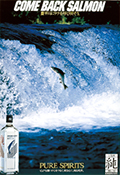
The Toyohira River in Hokkaido once brimmed with salmon, which would swim upstream to spawn. However, urbanization along the river’s banks had polluted the waters so badly that the salmon had disappeared completely. Yet some time later, small salmon runs were confirmed, and a local residents' movement to bring back the salmon began in earnest. Resonating with this initiative, Takara Shuzo decided to support it as part of its sales promotion, and started the "Come Back Salmon Campaign" in 1979. The phrase "Come Back Salmon" was engraved on the bottles of Takara Shochu Jun, and a portion of the proceeds of sales was donated to the conservation movement. This marked the start of the company's social contribution activities. (Photo: Campaign poster)
-

1984
-
Takara Can Chu-Hi makes a splash!
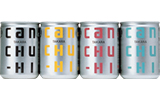
The success of Takara Shochu Jun resulted in new ways to drink shochu, such as freezing it and mixing it. This opened the way for the Chu-Hi craze and the new drinking fashion it engendered. Takara Can Chu-Hi (photo), which was launched in 1984, made a strong debut with commercials featuring John Travolta. On the heels of the Takara Shochu Jun hit product, Takara Can Chu-Hi was created as a new genre of light alcoholic beverages in the liquor market.
-

-
-
2
-
-
3
Launch of imports of alcoholic beverages from overseas
-
1971
-
Importing scotch whisky and Shaoxing rice wine to Japan
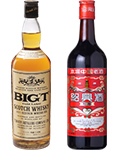
Following the 1971 liberalization of scotch whisky imports to Japan, Takara Shuzo formed an alliance with the Tomatin Spey Distillery, one of Scotland’s leading malt whisky producers. A new product, Big "T" Gold Label scotch (photo left) , was blended by Takara Shuzo from Tomatin’s rich selection of malts to suit the tastes of the Japanese market. Also eyeing Shaoxing rice wine, traditionally referred to as "one of the world’s three fine liquors," Takara Shuzo began importing and selling Touhai-brand Shaoxing rice wine (photo right) in 1976. Touhai has since grown into Japan’s top brand of Shaoxing rice wine.
-

1982
-
Entering the American sake market

Since the 1980s, Japanese cuisine has boomed in the U.S., and interest in sake has been increasing. Aiming to enter the US sake market, Takara Shuzo took a stake in the American sake brewer Numano Sake Co. in 1982. The following year, the company changed its name to Takara Sake USA Inc. in the U.S. and began producing and selling California-made Sho Chiku Bai (photo). Despite the difficulty of producing sake with different rice and water than in Japan, the company succeeded in achieving the same level of sake quality as in Japan through a series of innovations including a complete review of the production process.
-

1991
-
Takara Shuzo becomes the first Japanese company to enter management of bourbon maker

In 1991, as Takara Shuzo's overseas expansion was in full swing, including entry into the U.S. sake market and production and sales of Scotch whiskey, the company acquired a stake in AADC, the parent company of U.S.-based Age International, with whom we had a partnership for importing and selling bourbon whiskey such as Blanton's (photo). The following year, with the acquisition of all shares, AADC became a fully owned subsidiary.
-

-
-
3
-
-
4
Launching the biomedical business
-
1979
-
Entering the field of genetic engineering research with restriction enzymes
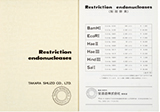
Following shochu, sake, and mirin, Takara Shuzo found its fourth business pillar: biotechnology, centering on genetic engineering technology. As demand for enzymes for research purposes, which are indispensable for genetic engineering experiments, was increasing, Takara Shuzo focused on restriction enzymes, which play the role of "scissors" that cut DNA. Under the guidance of university research institutions, four products were manufactured and released for the first time in Japan in 1979, which later that year grew to a total of seven. The following year, in 1980, Takara Shuzo launched sales of DNA ligase, which is the "glue" that connects individual strands of DNA. Eventually, the company achieved full-fledged biotechnology operations, exporting restriction enzymes and other reagents for genetic engineering research to Europe and the U.S. (Photo: The first catalog of restricted enzymes produced in Japan)
-

1988
-
Polymerase chain reactions and the biomedical business
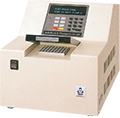
Having gradually built a foundation for its biomedical business, Takara Shuzo now saw the polymerase chain reaction (PCR) as a key element for its future growth in this field. PCR involves the use of heat-resistant DNA polymerases to generate millions of copies from a minute volume of DNA inside a test tube in a very short time. Takara Shuzo was the first company in Japan to focus on the promise of PCR, and in 1988, the company obtained exclusive domestic sales rights for a gene amplification system using the PCR method. Takara Shuzo had squarely entered the biomedical business. (Photo: PCR thermal cycler)
-

1988
-
Establishing a distribution agency network
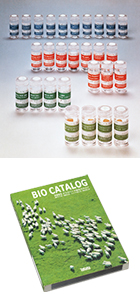
The sale of reagents for genetic engineering research (photo top) started out as direct sales, but for PCR systems, a faster and more flexible sales response was required. Takara Shuzo thus instituted a distribution agency network in 1988. In promoting the PCR method, demonstration sales conducted in cooperation with agents were very effective, and with the impetus of strong sales of PCR products, the company's distribution agency network was quickly completed. Even now, Takara Shuzo works to strengthen its cooperation system with distribution agencies as an ongoing process. (Photo bottom: Comprehensive Bio Catalog)
-

-
-
4
-
-
5
Entering the non-alcoholic beverage market and facing intense competition
-
1984
-
Minoru Kukita becomes the 7th president of Takara Shuzo
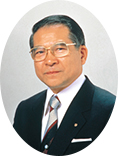
In 1984, Minoru Kukita (photo) became Takara Shuzo's seventh president. The following year, on the occasion of the 60th anniversary of the Takara Shuzo's founding, Kukita introduced a new corporate identity for the company and announced the company's policy of aiming to become a comprehensive provider of products manufactured with fermentation technology with three businesses: alcoholic beverages, pharmaceuticals (biotechnology), and food.
-

1986
-
The launch of Barbican and a non-alcoholic beverage business
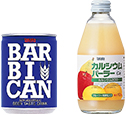
In 1986, Takara Shuzo launched Barbican (photo left) as a core product of its food business. Non-alcoholic beer, which offers the taste of beer without the alcohol, had been gaining support from consumers in Europe and the U.S., where people are more health-conscious, and Takara Shuzo developed this non-alcoholic beer to seize this trend. The company launched also Calcium Parlor (photo right), a functional beverage targeting health benefits under the slogan of "think health." Calcium Parlor was approved by the Ministry of Health and Welfare at the time for labeling as a "food for specified health uses" in 1993. In addition, Surioroshi Ringo ("freshly grated apple") drink launched in the same year, and with its unique name, became a hit product. However, stiff competition in this market segment prevented Takara Shuzo from establishing a secure foothold. Eventually, the company withdrew from the soft drink business and began to reposition itself as a producer of health foods.
-

1988
-
Akira Tanabe becomes the 8th president of Takara Shuzo
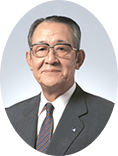
In the latter half of the 1980s, the environment in which the Japanese liquor industry operated grew more severe. Pressure on Japan from the EC (at the time) and elsewhere to revise the Liquor Tax Law to open up the liquor market increased, and GATT (General Agreement on Tariffs and Trade) recommended correcting the tax rate gap between whiskey and shochu. In addition, system reforms such as the deregulation of liquor sales licenses and the abolition of the sake classification system occurred one after another. In 1988, Akira Tanabe (photo) became the 8th president and began actively promoting business reforms such as the introduction of a system of business divisions to cope with the changing business environment. In 1990, Takara Shuzo formulated its first medium-term management plan to prepare for the coming competitive era.
-

-
-
5

